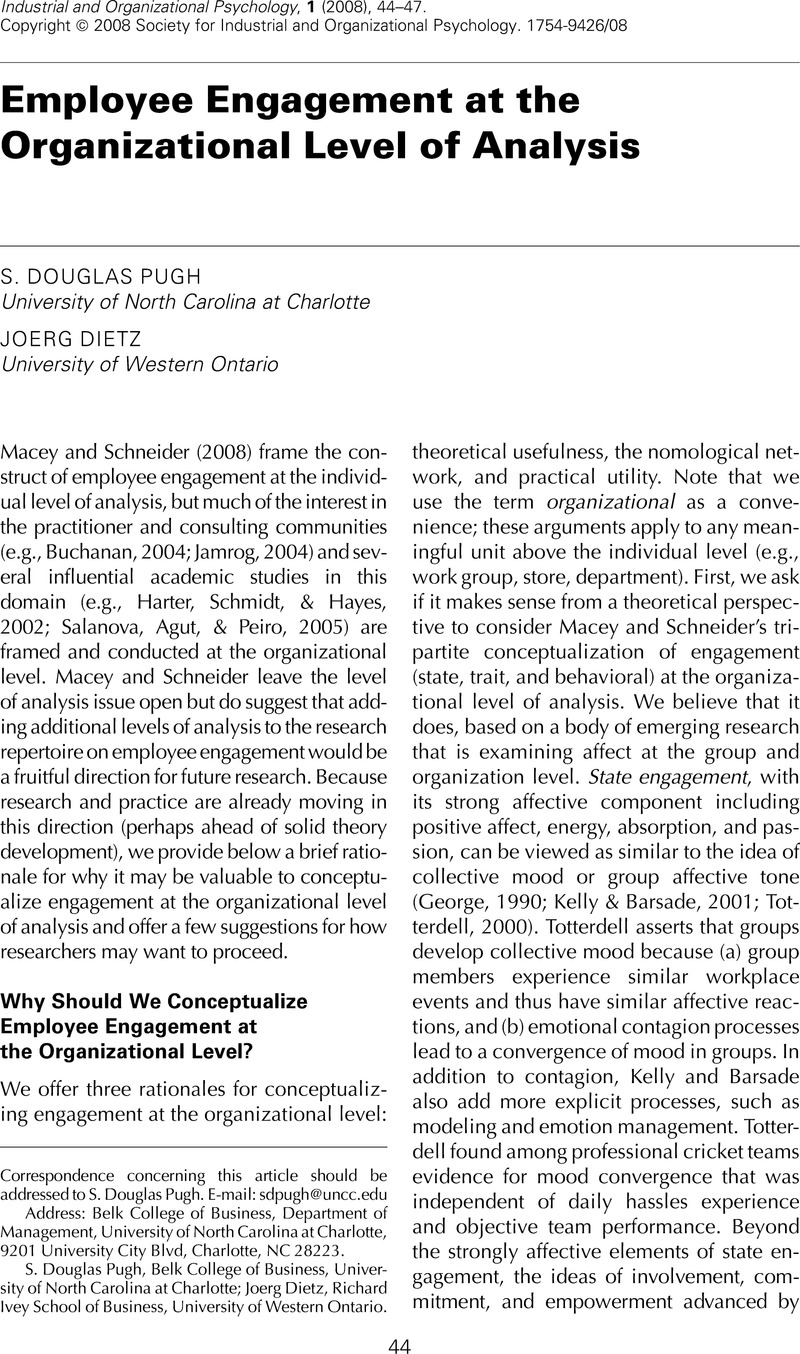Crossref Citations
This article has been cited by the following publications. This list is generated based on data provided by
Crossref.
Macey, William H.
and
Schneider, Benjamin
2008.
Engaged in Engagement: We Are Delighted We Did It.
Industrial and Organizational Psychology,
Vol. 1,
Issue. 1,
p.
76.
Attridge, Mark
2009.
Measuring and Managing Employee Work Engagement: A Review of the Research and Business Literature.
Journal of Workplace Behavioral Health,
Vol. 24,
Issue. 4,
p.
383.
Zigarmi, Drea
Nimon, Kim
Houson, Dobie
Witt, David
and
Diehl, Jim
2009.
Beyond Engagement:Toward a Framework and Operational Definition for Employee Work Passion.
Human Resource Development Review,
Vol. 8,
Issue. 3,
p.
300.
WHITMAN, DANIEL S.
VAN ROOY, DAVID L.
and
VISWESVARAN, CHOCKALINGAM
2010.
SATISFACTION, CITIZENSHIP BEHAVIORS, AND PERFORMANCE IN WORK UNITS: A META-ANALYSIS OF COLLECTIVE CONSTRUCT RELATIONS.
Personnel Psychology,
Vol. 63,
Issue. 1,
p.
41.
Welch, Mary
2011.
The evolution of the employee engagement concept: communication implications.
Corporate Communications: An International Journal,
Vol. 16,
Issue. 4,
p.
328.
Grandey, Alicia A.
Goldberg, Lori S.
and
Pugh, S. Douglas
2011.
Why and When do Stores With Satisfied Employees Have Satisfied Customers?.
Journal of Service Research,
Vol. 14,
Issue. 4,
p.
397.
Attridge, Mark
2012.
Handbook of Occupational Health and Wellness.
p.
441.
Agrawal, Vidhi
Chaudhary, Richa
Rangnekar, Santosh
and
Barua, Mukesh Kumar
2012.
Relationships between occupational self efficacy, human resource development climate, and work engagement.
Team Performance Management: An International Journal,
Vol. 18,
Issue. 7/8,
p.
370.
Rahman, Wali
and
Nas, Zekeriya
2013.
Employee development and turnover intention: theory validation.
European Journal of Training and Development,
Vol. 37,
Issue. 6,
p.
564.
Hassan, Shahidul
2013.
The Importance of Role Clarification in Workgroups: Effects on Perceived Role Clarity, Work Satisfaction, and Turnover Rates.
Public Administration Review,
Vol. 73,
Issue. 5,
p.
716.
Farndale, Elaine
E. Beijer, Susanne
J.P.M. Van Veldhoven, Marc
Kelliher, Clare
and
Hope-Hailey, Veronica
2014.
Work and organisation engagement: aligning research and practice.
Journal of Organizational Effectiveness: People and Performance,
Vol. 1,
Issue. 2,
p.
157.
Vera, María
Le Blanc, Pascale M.
Taris, Toon W.
and
Salanova, Marisa
2014.
Patterns of engagement: the relationship between efficacy beliefs and task engagement at the individual versus collective level.
Journal of Applied Social Psychology,
Vol. 44,
Issue. 2,
p.
133.
Shim, Dong Chul
and
Rohrbaugh, John
2014.
An Explanation of Differences Between Government Offices in Employees' Organizational Citizenship Behaviour.
Public Management Review,
Vol. 16,
Issue. 6,
p.
807.
Martin, Graeme
and
Cerdin, Jean-luc
2014.
Strategic Talent Management.
p.
151.
Athle, Deepa
Kumar, Aditi
and
Katiyar, Vinay
2014.
A culture of involving the vox populi for evolution of workforce policy.
p.
87.
Koch, Anna R.
Binnewies, Carmen
and
Dormann, Christian
2015.
Motivating innovation in schools: School principals’ work engagement as a motivator for schools’ innovation.
European Journal of Work and Organizational Psychology,
Vol. 24,
Issue. 4,
p.
505.
Haynie, Jeffrey J.
Mossholder, Kevin W.
and
Harris, Stanley G.
2016.
Justice and job engagement: The role of senior management trust.
Journal of Organizational Behavior,
Vol. 37,
Issue. 6,
p.
889.
Kunze, Florian
de Jong, Simon Barend
and
Bruch, Heike
2016.
Consequences of Collective-Focused Leadership and Differentiated Individual-Focused Leadership.
Journal of Management,
Vol. 42,
Issue. 4,
p.
886.
Tkalac Verčič, Ana
and
Pološki Vokić, Nina
2017.
Engaging employees through internal communication.
Public Relations Review,
Vol. 43,
Issue. 5,
p.
885.
Malik, Parul
and
Garg, Pooja
2017.
Learning organization and work engagement: exploring the nexus in Indian IT sector.
Asia-Pacific Journal of Business Administration,
Vol. 9,
Issue. 3,
p.
166.





